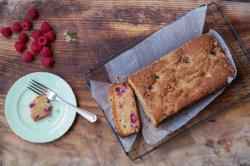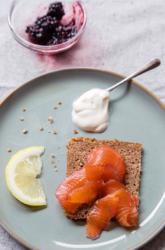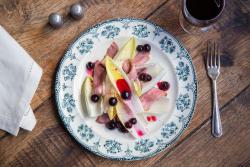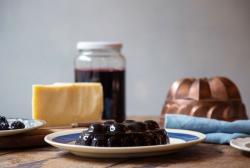Florence Knight; Head chef at Polpetto restaurant and Sunday Times Magazine’s Cook, has created a beautiful Taste of Summer Menu.
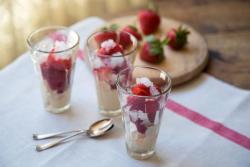 Strawberries, elderflower granita
Strawberries, elderflower granita
“Granita is at its best when eaten the moment it is ready. However, it will keep quite happily for several days in the freezer, if needed, although it will solidify considerably. In this eventuality, take it out of the freezer about an hour before you want to eat it, leave to defrost slightly, then beat again with a fork and pop it back in the freezer until needed.â€Â
500ml elderflower cordial
500ml water
450g (16 oz) or 1 large punnet of strawberries
140g (5 oz) thick double cream
- Mix the cordial with the water, pour it into a deep-sided dish and place it in the freezer.
- After half-an-hour or so, break up any ice that has formed in the tray with the teeth of a fork – the crystals will form first on the outside, so scrape them into the center of the tray.
- Repeat every half-hour or so, until the whole tray is full of rough ice crystals.
- Angle a small sharp knife and cut, in a circular motion, around the green leafy top of the strawberry and into the pale flesh directly underneath, discard this part. Halve any larger strawberries but leave the smaller ones whole.
- Lightly whip the cream.
- To serve, fold the strawberries into the cream, spoon into six pretty glasses and top with a generous spoonful of granita.
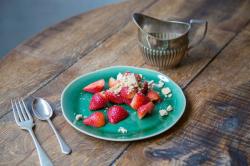 Strawberry, brown sugar meringue & cream
Strawberry, brown sugar meringue & cream
“A simple elegant dessert that will not fail to please. Meringues are not difficult to make, just a little delicate. Most importantly, make sure everything is dry and free of grease. You can make the meringue a few days ahead and store the shards in an air-tight container to help retain their freshness.â€Â
Serves: 6 people
100g (4 oz) caster sugar,
50g (2 oz) dark brown muscovado sugar,
75g (3 oz) egg whites at room temperature (approximately 2½ eggs)
1tsp cider vinegar
1 lemon
600g (21 oz) of strawberries
300ml double cream
Pre-heat the oven to 200C.
- Line a flat oven tray, preferably with a silicone mat but failing that greaseproof paper will do.
- Combine the caster sugar and dark brown muscovado sugar in a bowl and press them through a sieve onto the silicone mat.
- Spread the sugar over the mat evenly and cook it for about 8 minutes, until it has just begun to melt at the edges, but not to caramelize.
- It is essential that everything you use when making the meringues is grease-free, otherwise the egg whites will not stiffen.
- Wipe the inside of your mixing bowl and the whisk with the cut side of a lemon.
- Now add the egg whites to the bowl. As soon as you spot the sugar beginning to melt at the edges, set the mixer to whisk at high speed while you take the sugar out of the oven.
- Then turn the oven down to the lower setting of 60C.
- The eggs should be just foamy by the time you add the sugar. Using a cloth, very carefully pick up the corners of silicone mat and tip the hot sugar slowly into the still-whisking mixer.
- Continue whisking until the mixture is cool, glossy and will hold its shape, then add the splash of cider vinegar. This helps to balance the sweetness.
10. Re-line the baking tray with greaseproof paper and spoon the meringue on. Use a palette knife to spread it over the tray to about 1cm thick.
11. Place the tray into the oven on the lowest heat and bake until they are crisp on the outside, and sound hollow when tapped on the bottom; depending on their size, this could take up to 3 hours.
12. Allow the meringue to cool.
13. Hull the strawberries, halving any large ones, and place them bowls.
14. Crumble a little meringue over each bowl and serve with a jug of cream. Should any meringue be left, it is best stored in an air-tight container.
“The baked raspberries give moisture to this afternoon loaf, and the toasted hazelnuts lend greater depth of flavour. The perfect accompaniment to a cup of fragrant Earl Grey.â€Â
Serves: 6 generous slices
125g (4 oz) blanched hazelnuts
50g (2 oz) light brown sugar
100g (4 oz) caster sugar,
175g (6 oz) unsalted butter
2 eggs
a few drops almond extract
150g (5 oz) sifted self-raising flour
200g (7 oz) raspberries
2 tbsp whole milk
1 heaped tbsp Demerara sugar
Heat the oven to 160C and line a 1 kg loaf tin.
- Tip hazelnuts onto a baking tray and place it in the hot oven for three minutes. Pour the hot hazelnuts into a clean tea towel, wrap them up and rub them vigorously on the work surface to shed their skins. Pick the nuts from their husks and whizz them in a food processor for a minute until they are finely ground.
- Beat together light brown sugar, caster sugar and butter until it is very light. Slowly beat in eggs and a few drops of almond extract.
- Gently fold through sifted self-raising flour, keeping in as much air as you can.
- Finally fold in the carefully chosen, unblemished raspberries and the whole milk.
- Pour the mixture into your prepared tin and bake for 50 minutes until a skewer comes out of the cake’s center clean.
- Scatter over the Demerara sugar within the last five minutes of baking and cover with tin foil if the loaf looks like it’s taking on too much colour.
- Eat a generous slice whilst it is still slightly warm to the touch.
“Maldon sea salt or ground rock salt works particularly well for marinating the fish, while the blackberries add sweetness and turn the trout a vibrant deep purple. I like to eat this thinly sliced on slightly toasted rye bread with a spoonful of crème fraiche. This generously serves six people and it’s always best to make more, as it keeps well wrapped in the fridge for up to a week. It’s very simple to prepare, the hardest part is waiting thirteen hours for the perfect results.â€Â
900g, 1 sustainable salmon fillet skin on, scaled and pin boned
250g (9 oz) blackberries
375g (13 oz) light brown muscovado sugar
250g (9 oz) sea salt flakes
zest of 1 unwaxed lemon
2 tbsp gin
- Put the blackberries in a bowl and mash them into the salt and sugar. Zest over the lemon and stir through the mixture.
- Stretch two large pieces of cling film over a work surface and lay the salmon fillet onto it, skin side down. Brush your hand along the fillet to check for any little pin bones, pinching them out with a pair of tweezers.
- Pour the cure mixture generously over the fillet, wrap in cling film and leave on a tray in the fridge for thirteen hours.
- In the morning, rinse off the marinade under cold running water and pat the fillet dry.
- Bring the fish to room temperature and slice to serve on warm butter toast. Wrap any uneaten salmon in cling film and store in the fridge for up to a week.
“The sweetness of the blueberries gently tempers the crisp bitterness of the chicory leaves and makes this a very moreish light dish.â€Â
Serves: four people
120g (4 oz) caster sugar
240g warm water
2 tbsp lemon juice
½ tsp salt
150g or 1 punnet of blueberries
2 duck breasts
1 thyme sprig
25g (1 oz) butter
Sea salt & black pepper
4 small chicory bulbs, quartered lengthways
2 tbsp extra virgin olive oil
1 tbsp Moscatel vinegar
Sea salt and black pepper to taste
Preheat the oven to 180C/ 160C fan/gas 4.
- Dissolve the sugar in the water over a low heat. Once dissolved, turn the heat up and reduce the mixture for 10 minutes until it has a syrupy consistency.
- Add the lemon juice and salt followed by the blueberries and cook for a further 3 minutes, or just until the berries begin to burst and the liquor turns purple. This happens very quickly so keep a close eye on them. The blueberries will keep cooking in the hot liquor so it is best to take them off the heat early rather than risk over cooking.
- While the blueberries cool in their liquor, carefully score the skin of the duck breasts with a sharp knife – going only through the fat – and season well with salt and fresh black pepper.
- Heat a non-stick frying pan and place the duck breasts in it, skin-side down. Fry for 6-7 minutes, then turn the breasts over and add the thyme and butter. Allow this to melt, basting the duck with all the buttery juices, then transfer everything to a small roasting tin and finish in the oven for 5 minutes for medium rare or 10 minutes for well done.
- When the duck is ready, baste again with the juices from the pan and allow it to rest for 5 -10 minutes.
- In a small bowl whisk together the oil and vinegar then lightly fold through the chicory leaves along with all the duck resting juices.
- Thinly slice each duck breast on a chopping board and season with salt and pepper to taste.
- Loosely drape the chicory on a plate and fold through the duck pieces, finally spooning over the blueberries and juice. Enjoy immediately.
“This jelly is sweet and wobbly, as a jelly should be, but I like to eat it as a savory dessert with a thick piece of crumbly English cheese.â€Â
Makes approximately 1 kg
1 kg of blackberries
450 g (16oz) cooking apples, cored and finely chopped
4 bay leaves, washed and torn
Preserving jam sugar
- Wash the blackberries and apples. Place all the fruit and bay leaves into a preserving pan with 600ml/1 pint water
- Cook over a low heat gently for about 30 minutes until soft and very mushy
- Strain the pulp through a nylon sieve set over a bowl.
- Measure the resulting liquid and return it to the pan, adding 500g of sugar for each 500ml of liquor
- Stir over a low heat until the sugar has dissolved, bring the mixture to the boil and then reduce to a simmer, stirring regularly for 40-60 minutes.
- Check the bubbling mixture is ready by drawing a wooden spoon across the bottom of the preserving pan leaving a clean line.
- As soon as it is ready, pour the hot jelly into sterlised small jars, cover with waxed discs and seal. Skim away any scum from the top of the jelly and fill the jam jars to the brim. Cover, seal and label.
- Store in a cool, dark place until required.
- Alternatively pour the mixture into a greased mold that can be turned out for presentation. Best served with a few sliced of Kirkhams Lancashire cheese or cold, sliced roast beef.

